Müller Playing Cards
The Evolution of the Double Faced Swiss Pattern
Type
B |
|
late 1920s; 87 x 55 mm
No picture of this deck is available for this web page (these cards are very rare). See the museum guide of Swiss playing cards that was published for the according exposition: "Schweizer Spielkarten, Kunst Gewerbe Museum Zürich 11.XI.78-28.I.79". There on page 88, pattern 56 you can see these cards (even though black and white only).
On the ace of bell we read "Schaffhausen & Hasle". On the ace of shield we read the word "Spielkartenfabrik" (= playing card factory).
|
Type
C |
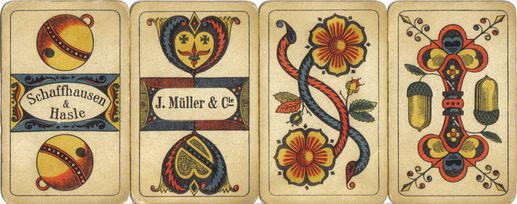 |
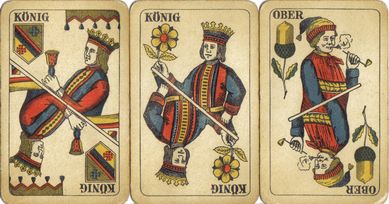 |
late 1920s - early 1930s (?); 86 x 54 mm
The most obvious change to pattern "B" is that on the ace of shield you now can read "J. Müller & Cie". Since I have no deck "B" at hand, I cannot point out any other differences.
|
|
Type
D |
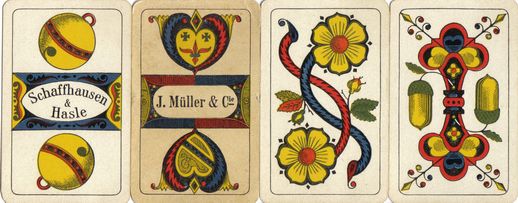 |
1930s and war years (?); 86 x 55 mm
With this evolution step the playing cards found their definitive appearance that will last for several decades. The ace and 10 of roses now also look like the roses of the courts and pips.
Since this deck of cards has poor printing quality there are two theories for a possible reason. The first one says that these cards were printed in the factories of Hasle and not of Schaffhausen. According the second one they were printed during the war years. The difference in printing can best be seen when looking at the colours green and yellow. These colours were printed over the colour black and cover it.
|
|
Type
E |
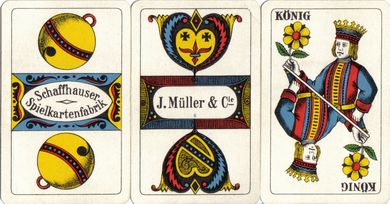 |
late 1940s - 1950s (?); 87 x 55 mm
In this evolution step there are only changes in colours. The leaves on the king of rose card changed from yellow to green. The king and the under of roses now have yellow hair (before white).
|
|
Type
Fa |
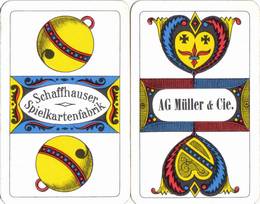 |
1960s (?); 87 x 55 mm
Müller changes its company structure and became a corporation, a joint-stock company. The letters "AG" on the ace of shield illustrates this. "AG" is the abbreviation for the German word "Aktiengesellschaft" (= stock company).
|
|
Type
Fb |
|
1970s (?); 87 x 56 mm
The pictures on the cards are the same. The only difference to the previous version is that these cards are 1 millimetre wider. Therefore this does not qualify as an own type.
|
|
Type
G |
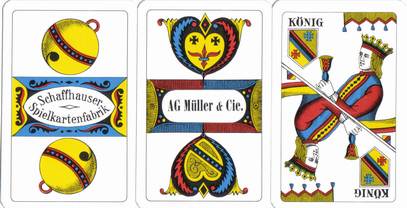 |
1980s (?); 89 x 57 mm
The only difference on the card pictures I noticed is on the king of shield card. There in the top right corner the fifth cord has disappeared again. More noticeable is that the cards have changed their format (2 millimetres taller and another millimetre wider). Interesting is that also the size of the frame has changed and now is at least 1 millimetre more in each dimension.
|
|
Type
H |
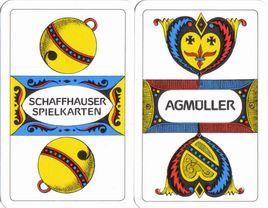 |
1990s (?); 89 x 57 mm
With "AGMÜLLER" they now use a more modern corporate identity.
|
|
Type
Ia |
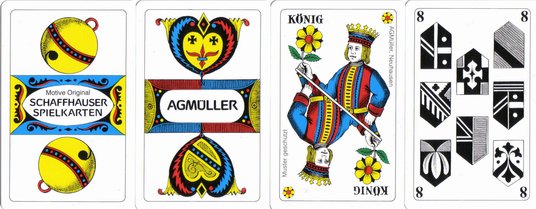 |
early 2000s (?); 89 x 57 mm
Müller in the meantime no longer is Swiss. In the year 1999 the Belgium Carta Mundi bought this company.
These cards show the biggest changes for more than 60 years! All court cards now have two suit indices and the pip cards have 4 and no longer 2 indices. You now have the manufacturer information on the king of roses: "AGMüller, Neuhausen" (despite that these cards were printed in Belgium). Also Müller (or Carta Mundi) claims the copyright on this pattern. They write "Muster geschützt" (pattern protected) on the king of roses and "Motive Original" (original motives) on the ace of bell.
|
|
Type
Ib |
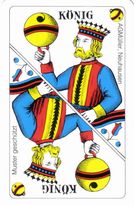 |
from 2005 on (?); 89 x 57 mm
The information ("AGMüller, Neuhausen" and "Muster geschützt") that was only on the king of roses, is newly printed on the king of bell as well.
|
|
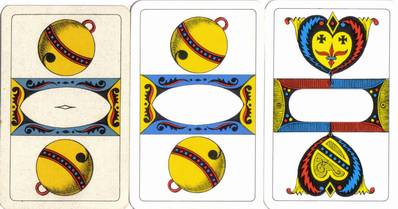 |
When you look at the aces of bell and shield you find no manufacturer information here. When you look at the other cards they are in all details identical to the Müller pattern. So these cards are clearly from Müller! The fist card from the left is an "E" pattern from the 1950s. The centre card is an "F" or "G" pattern. The card to the right corresponds to the "H" pattern, since the courts and pips have the additional indices.
But why does Müller want to hide its identity with these cards, since they have the same quality as the according "official" ones printed at the same time? The solution is quite simple. These cards were made for the big retailers in Switzerland such as Coop. They were sold much cheaper than the ones with the full manufacturer information. Müller did not want to risk its image of making high quality cards, but at the same time did not want to let other, especially foreign manufacturers, dominate the low cost segment.
 |
|
Since there are also foreign card manufacturers that have "blank" aces of bell and shield take a look at the ace of acorn as well. If the blue heart like figure has the shape as shown on the left picture then it is from Müller. If it looks diferent it is from an other manufacturer. This method of course is only applicable when there is no information on the other aces. |
|
|

